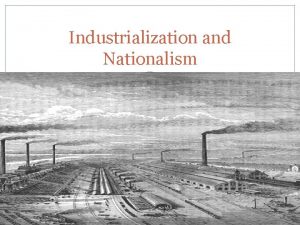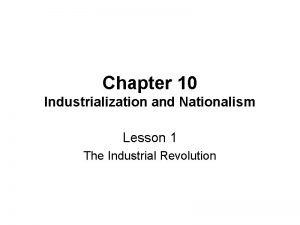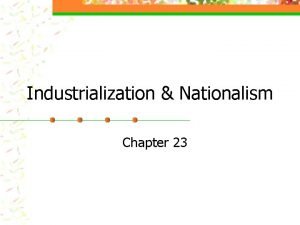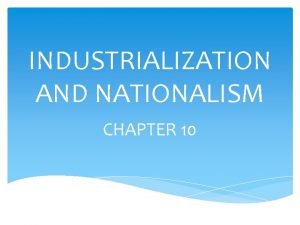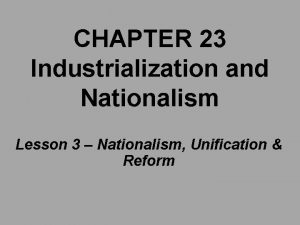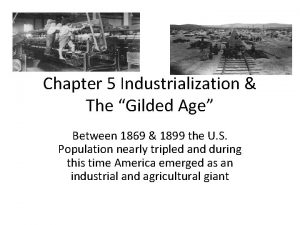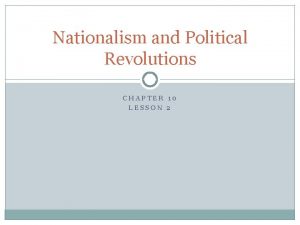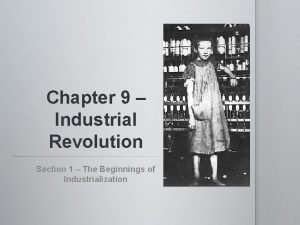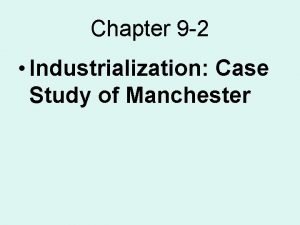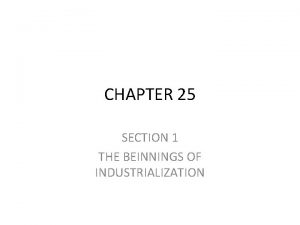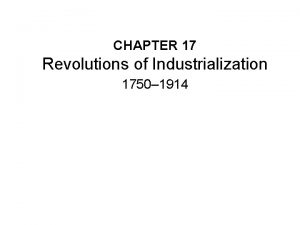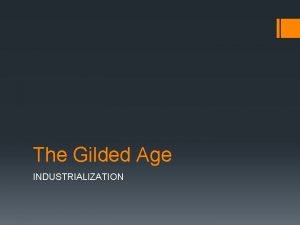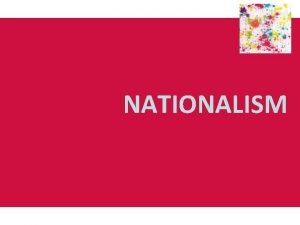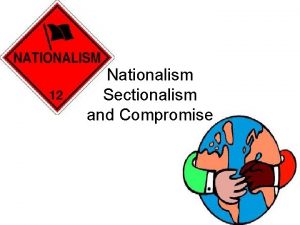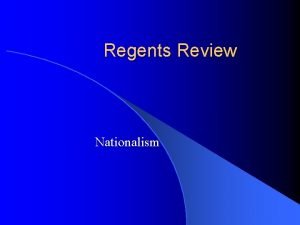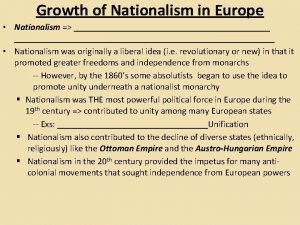CHAPTER 23 Industrialization and Nationalism Lesson 3 Nationalism















- Slides: 15

CHAPTER 23 Industrialization and Nationalism Lesson 3 – Nationalism, Unification & Reform

Both Germany & Italy are made up of many individual kingdoms & territories

Italian Unification Piedmont – a few kingdoms united under King Victor Emmanuel II Giuseppe Garibaldi: a loyal nationalist raised an army called the Red Shirts

Italian Unification Camillo Cavour: was named Prime Minister by King Victor Emmanuel II He made many political & military moves to strengthen their position From 1851 -1861 these three worked together to unite Italy

German Unification King William I – king of the strong state of Prussia Militarism – building up armies, troops & weapons in order to rely on military strength

German Unification Otto Von Bismarck – appointed Prussia’s prime minister by King William I *He started several European wars to show their strength, including one with France (the Franco-Prussian War)

German Unification

German Unification During this time, other strong countries were bringing reforms which benefitted their people

Great Britain 1. Allowed the middle class men to vote 2. Parliament was strengthened 3. Strong economy – wages rose 4. Queen Victoria – ruled from 1837 – 1901 brought stability & pride


France – Napoleon III was an authoritarian ruler who He: began to liberalize his regime 1. Rebuilt Paris & made it more modern 2. Gave the legislature more power 3. Fell after the loss of the Franco-Prussian War

Austria-Hungary 1. Two states with their own constitutions 2. One monarch: Franz Joseph (emperor of Austria & King of Hungary) 3. Common: army, foreign policy & economic system

Russia 1. Was hopelessly behind other countries 2. 1861 – serfs were freed – now they can own property – but only often could only purchase the least productive land


The United States 1. Struggle b/t state gov’ts & federal government for power 2. Slavery was a divisive issue 3. U. S. Civil War 1861 -65 resulted in the abolition of slavery
 Lesson quiz 10-2 industrialization and nationalism answers
Lesson quiz 10-2 industrialization and nationalism answers Industrialization and nationalism lesson 1
Industrialization and nationalism lesson 1 Lesson quiz 23-2 industrialization and nationalism answers
Lesson quiz 23-2 industrialization and nationalism answers -have strength to match the growth of industrialization
-have strength to match the growth of industrialization Chapter 23 lesson 3 nationalism unification and reform
Chapter 23 lesson 3 nationalism unification and reform Lesson 5 - industrialization
Lesson 5 - industrialization Lesson 3 big business
Lesson 3 big business Lesson 2 nationalism and political revolutions
Lesson 2 nationalism and political revolutions Chapter 9 section 3 industrialization spreads
Chapter 9 section 3 industrialization spreads Industrialization spreads chapter 9 section 3
Industrialization spreads chapter 9 section 3 Chapter 9 section 3 industrialization spreads answer key
Chapter 9 section 3 industrialization spreads answer key Chapter 9 section 1 the beginnings of industrialization
Chapter 9 section 1 the beginnings of industrialization Chapter 9 section 2 industrialization case study manchester
Chapter 9 section 2 industrialization case study manchester Chapter 9 section 1 the beginnings of industrialization
Chapter 9 section 1 the beginnings of industrialization Chapter 25 section 2 industrialization
Chapter 25 section 2 industrialization Chapter 17 revolutions of industrialization
Chapter 17 revolutions of industrialization
